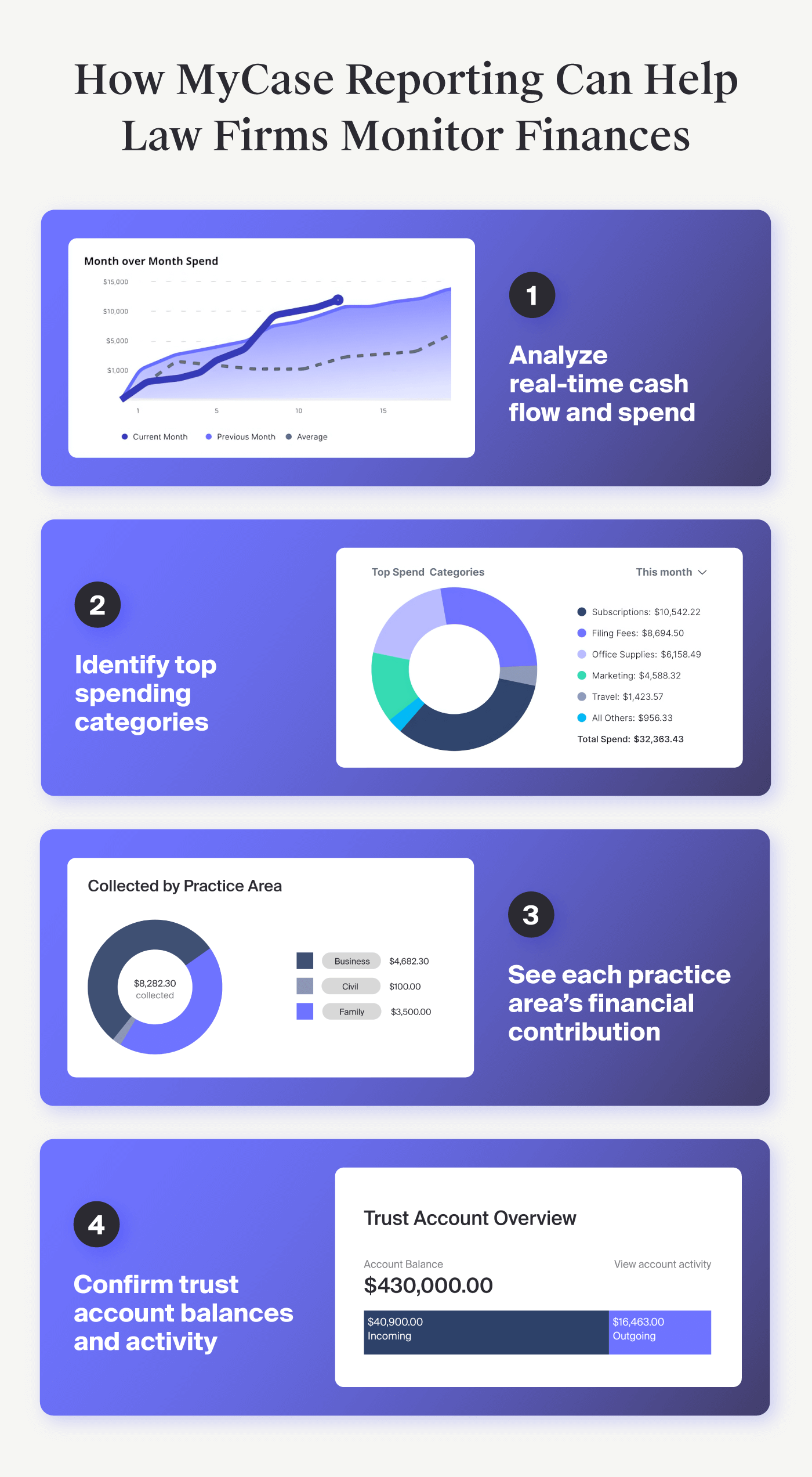Key takeaways
Legal spend management for law firms is the strategic process of tracking, overseeing, and streamlining spending to boost profitability and improve efficiency for clients and lawyers.
Do you know how much money flows into and out of your practice—and whether business expenses and profits serve your firm’s goals?
Managing monthly budgets, and keeping tabs on client and staff expenses, operating costs, and profitability are all key elements of a law firm’s legal spend management strategy. However, it’s easy to lose track of the details when you’re also managing multiple cases and clients.
The complexity of a law firm’s finances can also greatly vary between practice areas. For example, our 2024 Benchmark Report 1: Law Firm Finances found that personal injury firms had the highest average expenses per case (4.1) in 2023. However, family law-focused law firms had the highest total number of expenses in the same year.
“Legal spend management” is traditionally associated with in-house legal teams. However, spend management is essential to help law firms gain visibility over their finances and achieve their financial goals.
This article will go over best practices and tips for law firms, common challenges, and what to consider when selecting a law firm spend management solution.
What Is Legal Spend Management?
Legal spend management provides law firms the framework to monitor, control, and optimize their business expenses. By improving spending oversight, law firms can reduce costs, maximize value from company spending, and mitigate risks like financial misconduct.
Today, businesses leverage technology to expedite analysis and maintain a unified view of all company spending.
Legal spend management encompasses several key components and helps law firms:
Track and manage expenses by categorizing hard and soft costs, logging and capturing receipts, and billing clients accordingly for reimbursable expenses.
Establish process controls and oversight by creating spend pre-approval processes and post-spending analysis.
Implement effective budgets by setting limits for spending categories and company cards.
Enforce timely invoicing and collections by automating invoice generation, setting clear client expectations, and regularly sending reminders.
Generate and analyze financial reports by setting benchmarks, identifying trends, and monitoring ongoing financial performance.
Forecast future financial performance by analyzing profitability, cash flow, and outstanding accounts receivable.

Spend Management for In-House Legal
For in-house legal teams, spend management manages and controls costs associated with outside counsel, firms, and alternative legal service providers.
Spend management for in-house legal teams helps law departments:
Centralize and organize their spend data.
Track and monitor legal costs to inform decision-making.
Streamline operations by automating tasks such as invoices and workflows.
Spend Management for Law Firms
For firms, lawyers, and their teams and staff, law firm spend management helps control expenses and spending across all aspects of business. Thanks to spend management solutions and related software, this potentially daunting process has become increasingly accessible for firms of all sizes.
Spend management helps law firms:
Ensure constant visibility into, and control over, spending.
Increase profits and reduce revenue leakage.
Reduce financial risk, impropriety, and misconduct.
Save time from manual processes by leveraging automation.
How Spend Management and Expense Management Differs
While these concepts may seem similar, expense management and spend management have different scopes and objectives.
Expense management is one aspect of spend management and typically focuses on individual employee spending.
Spend management oversees the company’s total spending and the strategy behind maintaining the business’s financial health.
How to Improve Legal Spend Management
Improving your law firm spend management strategy can help you build a more profitable practice. Below are a few steps that can help you optimize your law firm cost management and ensure more informed, data-driven decisions.
1. Evaluate Your Firm’s Expenses and Operating Costs
Running the business side of your firm involves many moving pieces, and tracking your operating costs is the first step to tracking expenditures and optimizing profitability.
Start by identifying each law firm expense category within your firm and calculating the total spend for each category in the past month. Legal spend analytics can expedite this process by automatically categorizing all logged expenses. Otherwise, you may need to set aside time to compile and review past spreadsheets, receipts, and other legal expense tracking logs.
For categories, you can broadly group expenses into two types: operational costs and case-related costs.
Operational costs are essential business expenses. Example categories may include:
Office space rent or lease
Utilities
Office supplies
Software subscriptions
Hardware
Marketing and advertising
Staff salaries and benefits
Insurance for property, malpractice, and other areas
Case-related costs can vary and may be reimbursable by the client (depending on the fee agreement). Example attorney fees may include:
Travel and parking fees
Court filing fees
Expert witness fees
Legal research fees
Laboratory fees
After you’ve established your expense categories and mapped out their costs, review your firm’s spending trends to find areas for improvement.
Analyze yearly and monthly average spending for each category. Then, compare those numbers to your law firm’s budget. From there, you can more closely assess line items to identify where you may need to allocate more resources or cut back on expenses.
Many firms also use software to quickly identify these trends and provide real-time insight into their financial health. For example, MyCase Financial Reporting helps firms filter their spending data by generating numerous reports to provide a holistic view of a firm’s overall performance.
2. Establish Goals and Key Performance Indicators (KPIs)
Once you have your baseline data, you can begin setting financial goals and KPIs.
For example, you may uncover that your case costs are higher than anticipated. For example, after digging into the data and talking to your staff, you may learn that they’re struggling to keep up with legal expense tracking and forgetting to log all reimbursable expenses. You also may learn that clients have sometimes disputed these expenses, leading to unrecoverable case costs.
An example goal may be: Reduce case-related costs by 10% in six months by clearly communicating reimbursable expense expectations to clients and establishing a streamlined expense tracking process.
In addition to goal-setting, you can also establish measurable law firm KPIs to keep track of progress.
Example KPIs for the above goal may be:
Achieve a 40% reduction in billing disputes related to reimbursable expenses by the end of the quarter. We’ll measure this by comparing the number of disputes this quarter to the previous quarter.
Reduce hours spent tracking and logging expenses per employee by 25% by the end of the month. We’ll measure this by comparing the non-billable hours spent on expense logging this month to the previous month.
Improve case profit margins by 30% by the end of the year. We’ll measure this by comparing the total profit earned from each case compared to incurred expenses. We’ll check in on this metric each month and adjust strategies accordingly.
3. Develop and Train on Clear Spend Management Policies
Providing standardized training and establishing workplace policies can guide your firm toward its financial goals. These initiatives can help everyone understand how to accurately and efficiently manage their spending.
When building an invoicing and expensing policy, be sure to include:
Roles and responsibilities: Explain each team member’s duties related to spend management and who oversees certain tasks.
Approval processes: Create a step-by-step process for submitting, approving, and finalizing expenses.
Legal expense tracking requirements: Define what expenses are reimbursable, how staff should record expenses, and what supporting documentation they need for each expense.
Invoicing procedures: Specify invoice formatting, reimbursable expenses, and delivery methods.
Timing requirements: Establish a standardized timeline for invoice reviews, delivery, and payment follow-ups.
Client policies: Decide billing frequency, late payment fees, accepted payment methods, and communication guidelines for payment expectations.
Client consent procedures: Decide when you’ll need client signatures.
Accounts receivable process: Go over how your law firm manages accounts receivable, grace periods, and when to turn debts over to collections agencies.
Dispute resolution process: Cover how staff should manage disputes, escalation procedures, and potential resolutions.
Technology guidelines: Outline the steps for using the law firm’s expense management tools, invoice generation, and other finance-related software.
Once you’ve created these guidelines, dedicate time to reviewing them with staff, walking through processes, answering questions, and collecting feedback. This can help avoid confusion, process delays, and errors down the line.
Scheduling periodic reviews of these policies also allows your firm to identify necessary updates. For example, if your team found a more efficient process for logging receipts, ensure your guidelines reflect this change.
4. Leverage Automation and Spend Management Software
Clear processes and training are essential, but your staff may become overwhelmed if your workflow requires manual tasks like data entry. Excessive, time-consuming tasks may lead to inaccurate billing or overworked employees.
Technology and software can help improve your firm’s spend management strategy by automating tedious tasks and providing complete visibility into your law firm’s cash flow each month.
Legal spend management software like MyCase's Smart Spend solution is developed specifically for law firms and empowers practices to easily pay, track, and manage firm and client expenses.
With a complete picture of real-time insights and financial data, you can practice better cost control with your law firm, spot financial inefficiencies faster, and make more informed, data-driven decisions with your business’ finances.
Legal spend management systems are even more powerful with centralized case and financial data. For example, with MyCase, your law firm can automatically link case expenses to client accounts. Automating this process helps create more accurate invoices and prevent expenses from falling through the cracks.
Webinar
Financial Wellness for Law Firms: Using Data to Connect the Dots to Profitability
Download Webinars
5. Implement Regular Financial Reporting
Routinely reviewing legal spending insights and other financial reports can show you how you’re progressing toward your law firm’s goals—and if you need to make adjustments sooner rather than later.
Below are some examples of financial reports that your law firm may leverage:
Cash flow statements show how much money flows into the firm (e.g., from client work) and out (e.g., unreimbursable expenses).
Time and expense reports show the time spent on client matters and expenses incurred for a client. Depending on your reporting solutions, you may be able to view this based on individual employees, cases, and the total firm.
Profit and loss statements (also called income statements) show the firm’s revenue, costs, and expenses during a specific period to communicate total profit or loss.
Accounts receivable reports show clients and vendors who owe funds based on work performed.
Aging invoice reports show outstanding invoices that are grouped based on the number of days they are overdue (e.g. 1-15 days, 16-30 days).
Case revenue reports show what your law firm billed for cases compared to what your firm earned.
Balance sheets show your law firm’s assets, liabilities, and equity during a specified time period.
Client profitability analysis shows how your firm is generating income when examining the profitability of individual clients, legal matters, and practice areas.
Budget variance reports compare spending against budgets.
Tax returns summarize financial information for tax purposes, including tax breaks and deductions taken.
Trust account reports show an overview of a client’s trust account activity.
The following table goes over examples of financial reports, who may be involved in creating and reviewing them, and how often you may want to review these reports. Modify these recommendations based on your law firm’s goals.
Frequency | Example Financial Reporting | Who May Be Involved |
|---|---|---|
Weekly | Cash flow statement, time and expense reports, and trust account reports | Bookkeepers, legal assistants, paralegals |
Monthly | Profit and loss statements, accounts receivable, aging invoices, and case revenue reports | Accountants |
Quarterly | Balance sheet, client profitability analysis, budget variance report | Department heads, controllers |
Annually | Year-end balance sheet, year-end income statement, cash flow statement, tax returns | Controllers, tax professionals, external auditors |

Common Spend Management Challenges for Law Firms
Law firms face unique spend management challenges that can impact their growth and profitability. Below are a few of the most common challenges related to managing firm costs and example solutions.
Challenge | Example Solutions |
|---|---|
Increasing operational and legal costs | Renegotiating contracts, consolidating software subscriptions |
Lack of cost control | Implementing clear expense policies and approval workflows |
Profit leakage due to funds earned but not collected | Expanding payment methods and fee agreements, streamlining time and expense logging, optimizing invoice generation, and standardizing delivery |
Inadequate reporting, manual processes, and time loss | Automating tasks and leveraging legal spend management software |
Resistance to changing processes and tools | Communicating the benefits of change, providing ongoing training, and encouraging continuous feedback |
Benefits of Spend Management Software
Legal spend management solutions give firms more visibility and control over their finances—allowing them to gain a high-level view of all business spending. Below are just a few of the benefits of adopting this tool.
Improved Firm Profitability
Law firm spend management software protects your profit margins and cash flow by accurately tracking case-related expenses. For example, a spend management solution can capture digital receipts, automatically add case expenses, and instantly generate client invoices.
And it’s easy to use. With MyCase Smart Spend, simply:
Spend: Make a charge.
Snap: Take a photo of the receipt.
Submit: Add relevant expense details.
Sync: MyCase syncs submitted expense data to the specified case.
Repeat.
By automating this process, your law firm can minimize revenue leakage and gain better control over your spending.
Increased Operational Efficiency
With law firm spend management software, your firm can say goodbye to manual receipt tracking and tedious expense entry tasks. The software automatically tracks your case-related expenses to streamline accounting processes and simplify end-of-month reconciliation.
This helps your law firm:
Reduce time spent on repetitive tasks.
Minimize manual entry errors.
Ensure a more accurate financial overview.
Free up time for firms to focus more on what really matters: serving clients.
Better Visibility Into Firm Spending With Analytics
From detailed legal spend analytics to monthly finance reports, law firm spend management software dives deep into your firm’s finances to identify cost-saving opportunities and reduce financial impropriety. With real-time insights into expenses, you gain full visibility into all spending for maximum control, transparency, and sustainability.
Furthermore, gaining access to this financial data, your law firm will be able to benchmark performance against industry averages.
You can participate in surveys like the ones offered by PwC. You can also informally compare your financial performance by reviewing legal industry reports, like those from CBRE, the American Bar Association, and MyCase.
Essential Features for Law Firm Spend Management Software
While there are numerous legal spend management solutions available today, they primarily solve the needs of in-house legal teams. However, new software is emerging—and that’s good news for law firms.
When searching for the right law firm spend management software, here are the must-have features to look for:
Reporting and dashboards: Understanding your finances shouldn’t require decoding. Look for software that simplifies oversight with a comprehensive dashboard and easy-to-read reports.
Expense tracking: The right software ensures you never miss another reimbursable expense. Find a solution that streamlines billing by automatically adding reimbursable expenses to client invoices while on the go.
Budget spend limits: Controlling spend can help your law firm proactively prevent financial risk. Prioritize software that lets you set spend limits for cards, categories, and staff. The right technology should also let you easily manage monthly budgets with pre-approved spend categories.
Integrations: If you already use other financial software, check for solutions that seamlessly sync information to avoid silos. You may also want to consider finding a tool that serves all of your needs to minimize the tools your firm uses.
Centralized case and financial data: Identify a solution that keeps all data in one spot rather than using separate solutions for case management and financial management. Unification can enable better and more complete insights into a case. It also simplifies your tools and optimizes your firm’s workflows.
Improve Spend Management With MyCase Smart Spend
Having a spend management system and strategy plays an important role in your firm's financial efficiency and profitability. While legal spend management systems have traditionally been developed to meet the needs of in-house legal teams, a new spend management solution has emerged—and it’s a game changer for law firms.
MyCase Smart Spend is the first spend management tool purposely built and developed to meet the unique needs of law firms. With this powerful solution, your firm can protect profit margins, control cash flows, and gain insights into monthly firm finances.
Smart Spend provides real-time monitoring and controls that eliminate risky manual data entry and reduce the risk of internal financial misconduct. You’ll maintain better control and gain greater visibility into your firm's expenses and spending. Smart Spend is available in MyCase, CASEpeer (the #1-rated practice management software for personal injury firms), and LawPay (the top-rated legal payments solution trusted by 50,000+ lawyers).
Ready to say goodbye to cash flow uncertainty and profit leakage? Schedule a MyCase demo to learn how this solution can revolutionize your firm’s spend management strategy.
About the author

Sammi JonesSenior Content Writer and Editor
Sammi Jones is a Senior Content Writer and Editor for leading legal software brands, including MyCase, Docketwise, CASEpeer, and LawPay—the #1 legal payment processor. She covers the latest advancements in legal technology, financial wellness for law firms, and key industry trends.
